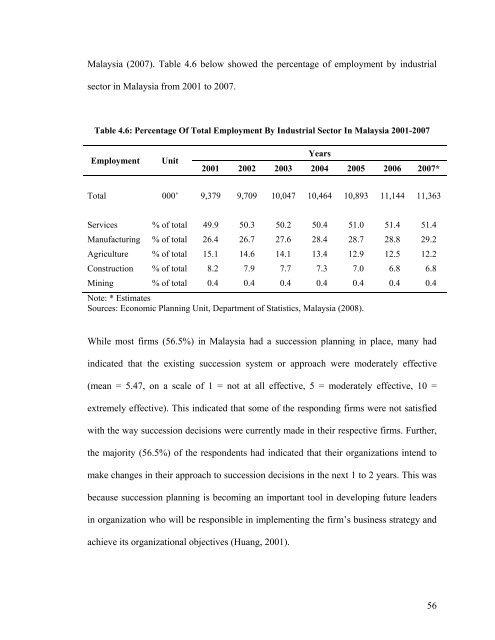CHAPTER 1: INTRODUCTION 1.0 Chapter Overview - DSpace@UM
CHAPTER 1: INTRODUCTION 1.0 Chapter Overview - DSpace@UM
CHAPTER 1: INTRODUCTION 1.0 Chapter Overview - DSpace@UM
You also want an ePaper? Increase the reach of your titles
YUMPU automatically turns print PDFs into web optimized ePapers that Google loves.
Malaysia (2007). Table 4.6 below showed the percentage of employment by industrialsector in Malaysia from 2001 to 2007.Table 4.6: Percentage Of Total Employment By Industrial Sector In Malaysia 2001-2007EmploymentUnitYears2001 2002 2003 2004 2005 2006 2007*Total 000’ 9,379 9,709 10,047 10,464 10,893 11,144 11,363Services % of total 49.9 50.3 50.2 50.4 5<strong>1.0</strong> 51.4 51.4Manufacturing % of total 26.4 26.7 27.6 28.4 28.7 28.8 29.2Agriculture % of total 15.1 14.6 14.1 13.4 12.9 12.5 12.2Construction % of total 8.2 7.9 7.7 7.3 7.0 6.8 6.8Mining % of total 0.4 0.4 0.4 0.4 0.4 0.4 0.4Note: * EstimatesSources: Economic Planning Unit, Department of Statistics, Malaysia (2008).While most firms (56.5%) in Malaysia had a succession planning in place, many hadindicated that the existing succession system or approach were moderately effective(mean = 5.47, on a scale of 1 = not at all effective, 5 = moderately effective, 10 =extremely effective). This indicated that some of the responding firms were not satisfiedwith the way succession decisions were currently made in their respective firms. Further,the majority (56.5%) of the respondents had indicated that their organizations intend tomake changes in their approach to succession decisions in the next 1 to 2 years. This wasbecause succession planning is becoming an important tool in developing future leadersin organization who will be responsible in implementing the firm’s business strategy andachieve its organizational objectives (Huang, 2001).56
















